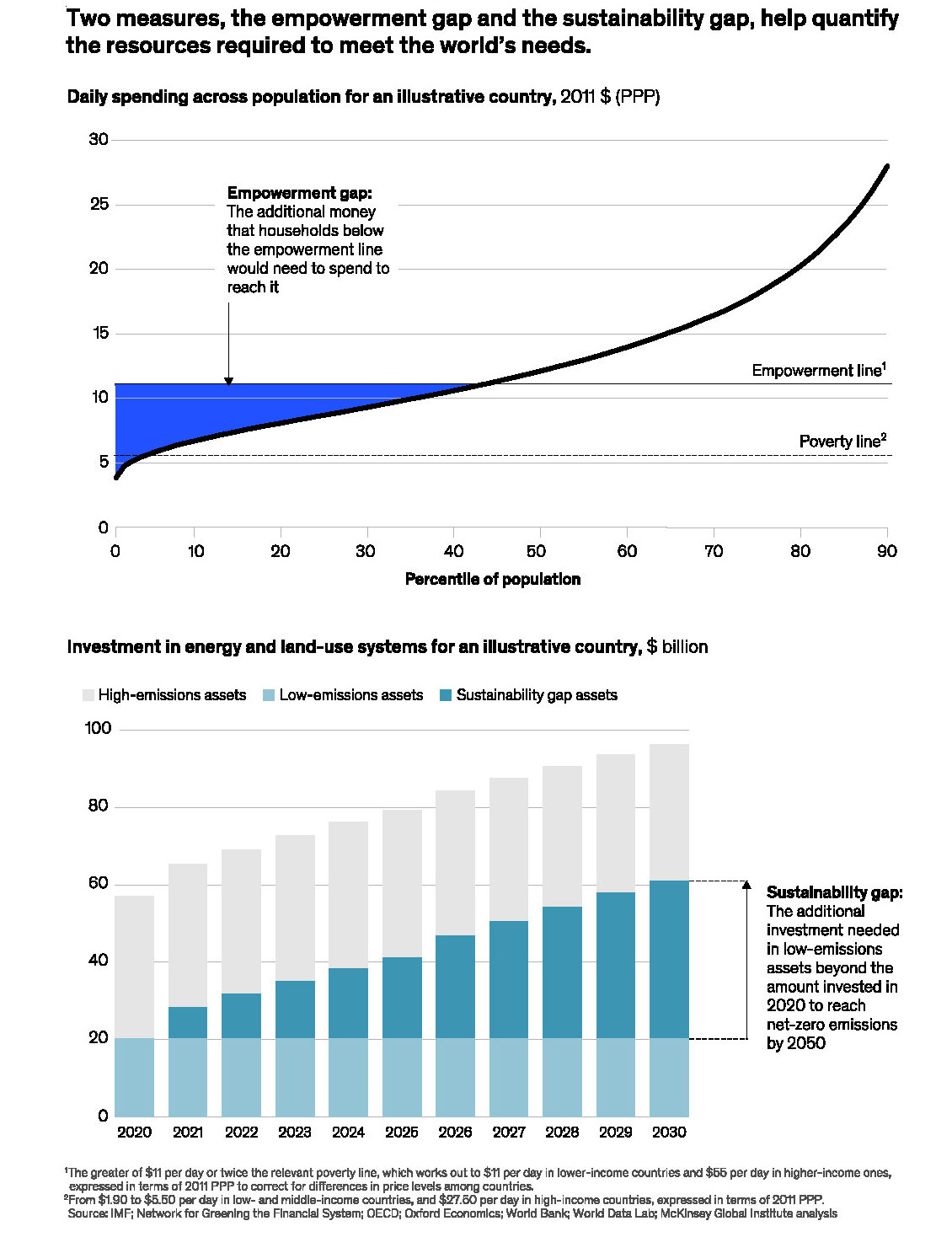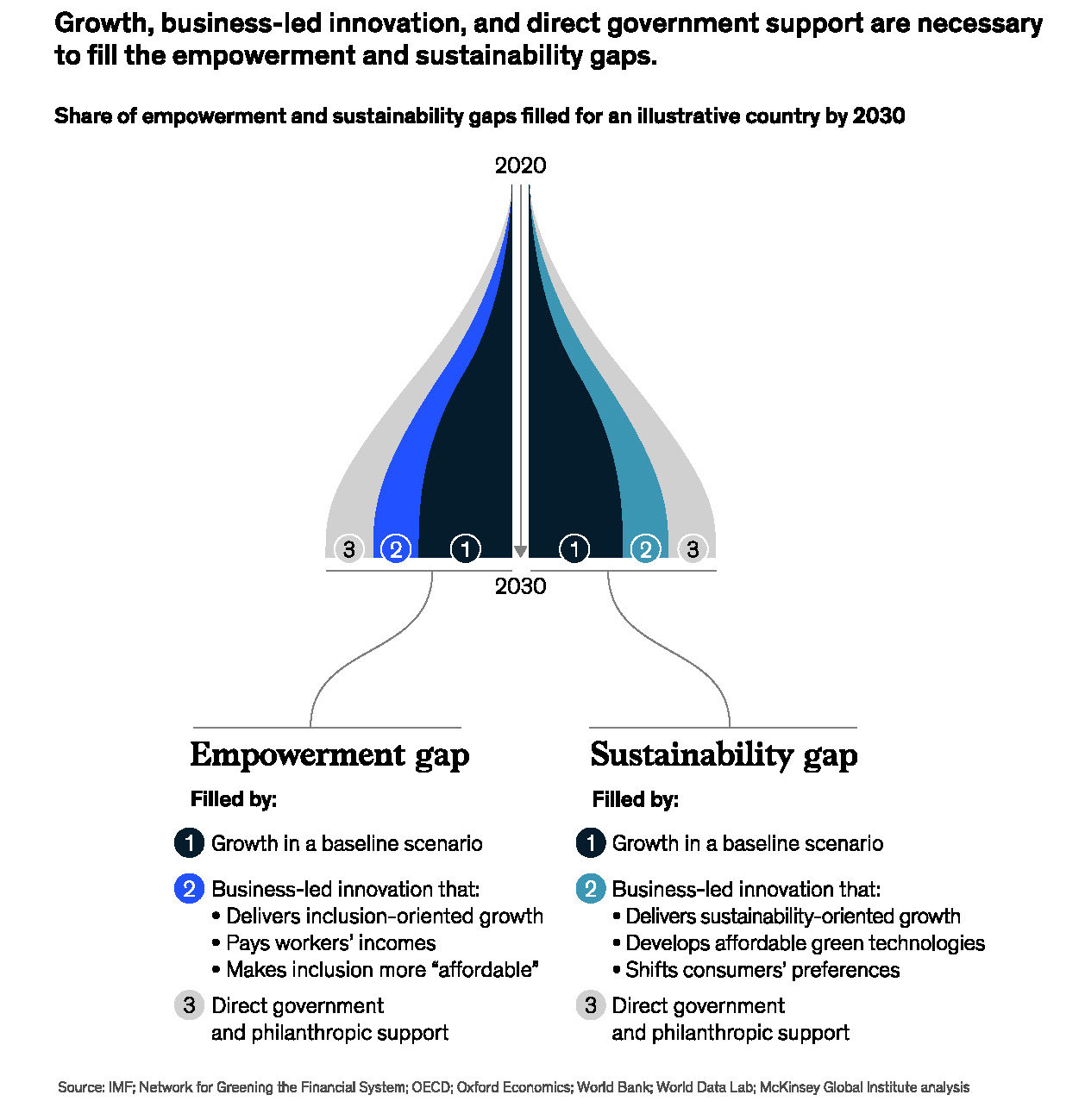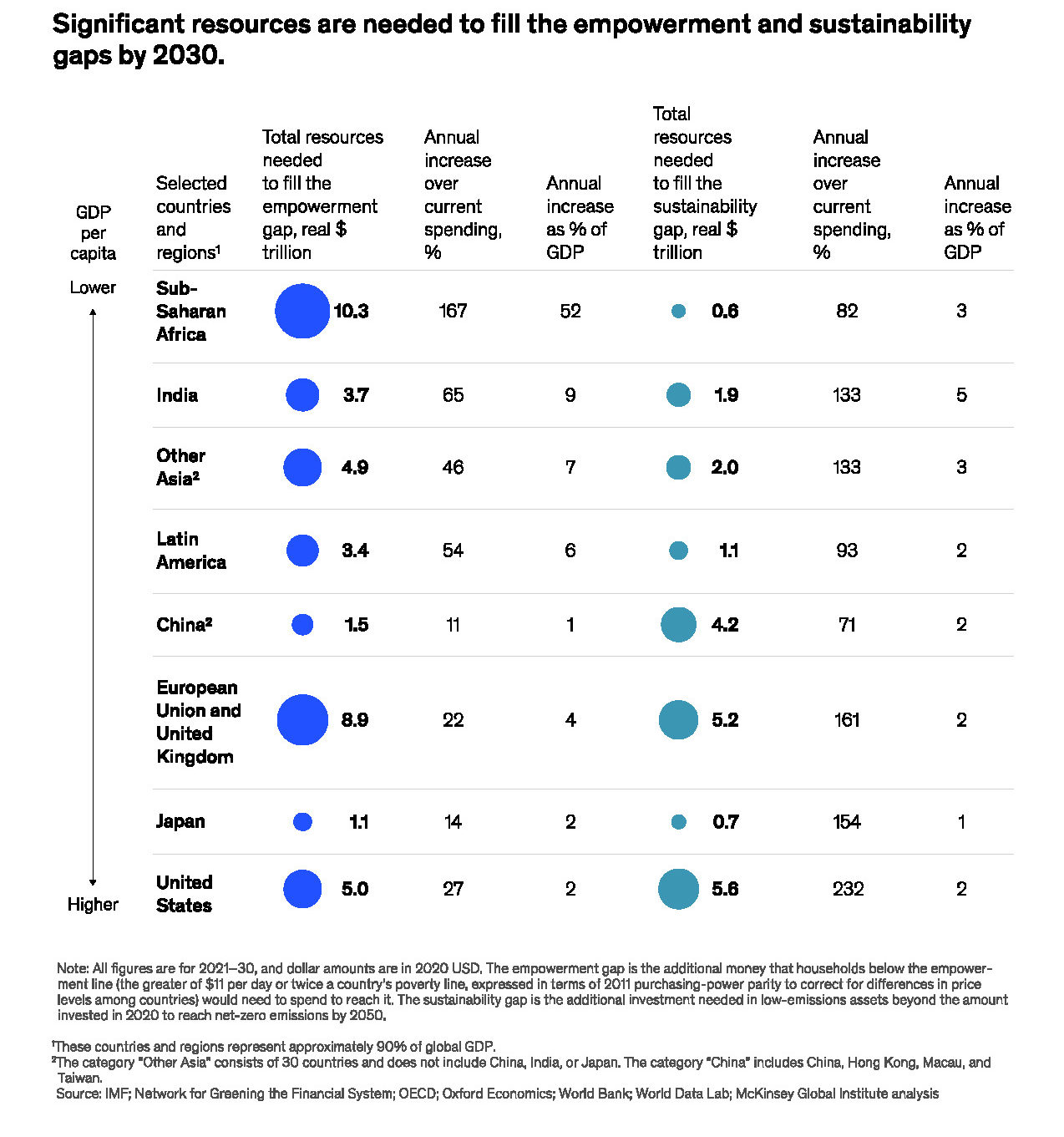Toward a sustainable, inclusive, growing future: The role of business
To make the world as sustainable and inclusive as we hope, a certain kind of economic growth will be necessary—and companies will play a vital role in generating it.
How should the world confront its most pressing environmental and social challenges? An answer lies in sustainable, inclusive growth—that is, economic growth that provides the financial resources needed to contain climate change, promote natural capital and biodiversity, empower households, and promote equitable opportunity. Any effort to usher in such growth will need many stakeholders, but businesses, which drive more than 70 percent of global gross domestic product (GDP), will be a key player.

Exhibit 1 What the world needs within this decade to become as inclusive and sustainable as we hope. Source: McKinsey graphs
The challenges to sustainability and inclusion are large and urgent. On the sustainability side, energy efficiency is reducing emissions of CO2 (carbon dioxide) and other greenhouse gases in some countries, but worldwide emissions continue to rise, accelerating climate change and its attendant physical risks. The world is therefore on track to exhaust its “carbon budget,” the amount of greenhouse gases it can emit without triggering dangerous levels of warming, by 2030. As for inclusion, though in some ways the world has become more inclusive over the past few decades, billions of people still live in countries that could do far better on such measures as life expectancy, child mortality and gender parity in labor force participation. The current decade will determine whether we opt for sustainable, inclusive growth or for dangerous warming and large segments of society left behind.
What the world needs
In this research, which was presented at the 2022 Business 20 summit in Indonesia, we use two measures to quantify what the world needs within this decade to become as inclusive and sustainable as we hope (Exhibit 1). The empowerment gap is the spending capability that all households in a given country would require in order to meet basic needs, have discretionary income and be able to weather emergencies—in effect, to join the middle class. The sustainability gap is the amount of additional annual investment in low-emissions technologies that a country would need to make in order to move the world to a pathway resulting in net-zero emissions by 2050. The size of the gaps varies from country to country, but they are enormous everywhere (Exhibit 2).
To fill those gaps, the world must experience solid and sustained economic growth. Growth is necessary because it creates income for people—who must either spend the income, save it or invest it. Some of the income that is consumed will raise households to empowered levels of spending, and some that is saved or invested will help build the infrastructure needed for the net-zero transition.
But growth on its own will not be enough. For example, assume that in the United States, the economy grows for the rest of this decade at a baseline rate of 2.1 percent per year, and the current pattern of resource allocation does not change. (We make that conservative assumption so that we can illustrate the shifts needed from today, even though reallocations are already underway on the sustainability front.) In that case, only 36 percent of the country’s empowerment gap and 7 percent of its sustainability gap will be filled by 2030. The numbers vary among the countries and regions that we studied, but baseline growth would fill more than half of the empowerment gap in only two—India and China—and more than half of the sustainability gap in none.
Article continues after this advertisement
Exhibit 3 Aside from economic growth, the two remaining ingredients necessary to fill the gaps are government intervention and business-led innovation.
Two remaining ingredients are necessary to fill the gaps entirely (Exhibit 3). One is government intervention, which can steer incentives and public resources to sustainability and inclusion. The other is business-led innovation. Such innovation can accelerate growth beyond our baseline, leading to still more spending, saving and investing. It can make inclusion and sustainability more “affordable” by reducing the cost of products and services that further those goals. On sustainability, for example, as the unit costs of low-emissions alternatives (such as electric vehicles, renewable energy and heat pumps) come down, they will attract more private capital, reducing the total investment need. And when innovation makes low-emissions technology cheaper, it can help close the sustainability gap further by shifting consumers’ preferences toward that technology. Such advances can also affect inclusion if they reduce any medium-term rise in costs associated with the large transition outlays needed. When accompanied by strategies and public policy that enable education, training, childcare, healthcare and inclusive hiring, business-led innovation can also help close the empowerment gap by boosting workers’ incomes.
Article continues after this advertisementBusiness-led innovation is a major reason that companies will be crucial in any successful undertaking for sustainable, inclusive growth. Another reason is that companies are sometimes linked to existing challenges; for example, the share of their income that goes to their workers has fallen over the last two decades. The problem is that it is difficult for an individual company to resist market incentives. Take the case of a company that emits large quantities of CO2. If reducing those emissions would put it at a disadvantage with its competitors, it has little financial reason to proceed.
What to prioritize
In this discussion paper, we provide a framework for businesses to help them start determining which challenges they can tackle while realizing the financial returns that attract capital. Two main approaches are possible: acting through existing market opportunities and helping shape new ones. Within each approach are two subcategories, so that companies can choose among four distinct paths that require progressively more collaboration: acting independently, collaborating with each other to shape industry standards, partnering with governments to execute specific projects or programs and working with governments to craft the markets of the future.
Companies that are trying to sort potential projects into that framework could usefully ask three questions about each:
How great are the societal returns, and how long will it take to realize them? Projects that yield extremely high societal returns over long periods may be good candidates for collaborations and partnerships rather than individual action.
What degree of orchestration is needed? If a great deal is necessary—because complementary capabilities among companies, government, and the social sector are needed, and because the beneficiaries are dispersed—that is another sign that a project is ripe for collaboration.
Where can public and philanthropic capital catalyze larger flows of private financing? There is no shortage of such financing, so the answer could well determine where trillions of dollars flow.
The need for a more sustainable, inclusive, and growing world is pressing. So is the need to prioritize the tasks that would bring about such a world. We hope that this research and framework will help companies do the important work of setting priorities and convening the right partnerships so that they can move swiftly from aspiration to action. —contributed INQ
Sven Smit, a McKinsey senior partner and chair of MGI, is based in Amsterdam. Anu Madgavkar is an MGI partner in New Jersey. Kevin Russell is an MGI senior fellow in Charlotte. Jonathan Woetzel is a McKinsey senior partner and MGI director in Shanghai. Tracy Francis is a McKinsey senior partner in São Paulo. Kweilin Ellingrud is a McKinsey senior partner and MGI director in Shanghai. Vivek Lath is a McKinsey partner in Singapore. Phillia Wibowo is a McKinsey partner in Jakarta. Rebecca Anderson, an MGI fellow in New Jersey, led the research team.
Anushka Baloian, Cameron Davis, Esther Saerang and Aditya Tata also contributed to this article.
This article was edited by Benjamin Plotinsky, MGI senior editor in Washington, DC.
